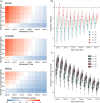Synchronized nonpharmaceutical interventions for the control of COVID-19
- PMID: 34035561
- PMCID: PMC8138095
- DOI: 10.1007/s11071-021-06505-0
Synchronized nonpharmaceutical interventions for the control of COVID-19
Abstract
The world is experiencing an ongoing pandemic of coronavirus disease-2019 (COVID-19), which is caused by severe acute respiratory syndrome coronavirus 2 (SARS-CoV-2). In attempts to control the pandemic, a range of nonpharmaceutical interventions (NPIs) has been implemented worldwide. However, the effect of synchronized NPIs for the control of COVID-19 at temporal and spatial scales has not been well studied. Therefore, a meta-population model that incorporates essential nonlinear processes was constructed to uncover the transmission characteristics of SARS-CoV-2 and then assess the effectiveness of synchronized NPIs on COVID-19 dynamics in China. Regional synchronization of NPIs was observed in China, and it was found that a combination of synchronized NPIs (the travel restrictions, the social distancing and the infection isolation) prevented 93.7% of SARS-CoV-2 infections. The use of synchronized NPIs at the time of the Wuhan lockdown may have prevented as much as 38% of SARS-CoV-2 infections, compared with the unsynchronized scenario. The interconnectivity of the epicenter, the implementation time of synchronized NPIs, and the number of regions considered all affected the performance of synchronized NPIs. The results highlight the importance of using synchronized NPIs in high-risk regions for the control of COVID-19 and shed light on effective strategies for future pandemic responses.
Supplementary information: The online version contains supplementary material available at 10.1007/s11071-021-06505-0.
Keywords: COVID-19; Infection isolation; Nonpharmaceutical interventions; Social distancing; Synchronization.
© The Author(s), under exclusive licence to Springer Nature B.V. 2021.
Conflict of interest statement
Conflict of interestThe authors declare no competing interests.
Figures





References
LinkOut - more resources
Full Text Sources
Other Literature Sources
Miscellaneous
